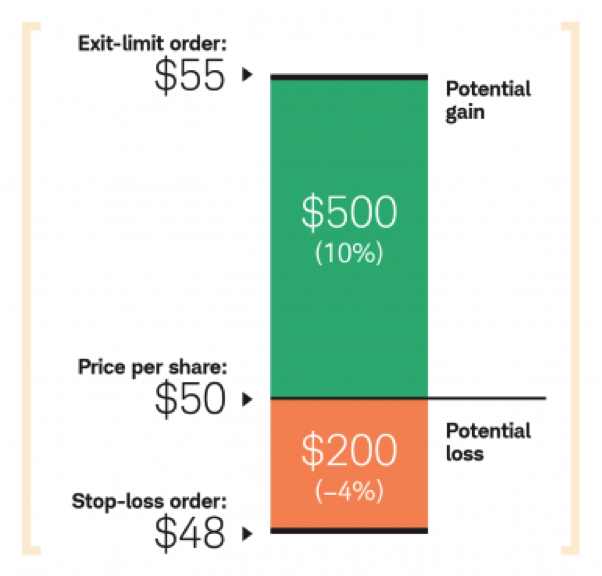When it comes to investing, everybody hates mistakes — like losing money on a bad investment or cashing out before the market rebounds. However, the stakes are even higher for traders, who buy and sell far more frequently than long-haul investors, and whose trading accounts may not be as diversified as, say, a retirement portfolio.
Here are some of the most widespread behavioral biases I've witnessed among active traders — and my advice for overcoming each.
1. Loss aversion
The average person feels the pain of financial loss twice as much as he or she does the pleasure from financial gain1 — and traders are no different. The trick, then, is not to avoid loss but to manage it. Before you initiate any trade, decide how far you're willing to let the stock drift before you sell. All things being equal, you want your winners to earn double to triple the amount you're willing to sacrifice on your losers.
This is where so-called bracket orders can help. By placing limit orders for both profits and losses, you can mitigate the natural inclination to exit your profitable positions too soon and maintain your losing positions too long. For example, say you bought XYZ Corp. at $50 per share. With a bracket order, you can set a stop-loss order at $48 and an exit-limit order at $55. That way, the most you're risking is $2 per share, while maintaining a profit potential of $5 per share — an approach that theoretically allows you to accumulate more losses than gains and still come out ahead. (See "Breaking down bracket orders," below.)
Breaking down bracket orders
A trader purchasing 100 shares of XYZ Corp. at $50 per share sets an exit-limit order and a stop-loss order; this so-called bracket order allows for a potential gain that's two-and-a-half times the potential loss.

2. Revenge trading
When a trade is going against you, you may be tempted to try countering those losses by doubling or tripling down as the stock continues to drop — something known as revenge trading. But it can take months or even years for such a stock to recover — if it recovers at all — and that's much too long for most traders to hold a losing position. Worse, you increase the odds that an already bad trade will turn catastrophic.
So what's a trader to do? Make sure you identify in advance how much you're willing to lose with each trade — no more than 1 percent to 2 percent of your total trading capital, all things being equal. That means a trader with $50,000 on hand shouldn't risk more than $1,000 on any single transaction.
3. Shirking the blame
Although it's natural to blame losses on outside forces instead of our own oversights, it sets us up for further failure down the road. The solution lies in an impartial grading mechanism that tells you how strong your performance truly is. (See "Test your strength," below.)
Comparing your trading portfolio to a benchmark or group of benchmarks is another way to go. The most widely used stock market benchmark is the S&P 500® Index, but it isn't always the best gauge of an individual's trading portfolio. If you consistently fall short, it may be time to revisit your strategy or seek out the help of a professional.
4. Negativity
The length of the current bull market has plenty of traders convinced of its imminent collapse, despite all evidence to the contrary. So do your homework, and if a longtime trend still appears to have legs, let your winners run. Even if the market turns against you, your stop-loss orders and other risk-management strategies can help protect your downside — before you pivot your portfolio to take advantage of the correction.
Go-to guardrails
Five tips for trading smart.
- Limit your losses: Identify in advance how much you're willing to lose with each trade—no more than 1 percent to 2 percent of your total trading capital, all things being equal.
- Overweight your winners: Generally speaking, you want your winners to earn double to triple the amount you're willing to sacrifice on your losers — by setting an exit-limit order at two to three times your stop-loss, for example.
- Go your own way: If, after doing your homework, a longtime trend still appears to have legs, let your winners run — however contrary to conventional wisdom.
- Measure your progress: Schwab clients can compare their portfolios' risk and return to a benchmark or group of benchmarks using Schwab's Portfolio Risk & Return tool (schwab.com/riskandreturn).*
- Test your strength:Schwab clients enrolled in Schwab Trading Services can use the Gain/Loss Analyzer (schwab.com/analyzertool),† shown below, to accurately gauge their performance.† It reveals not only a trader's average gain and loss but also the ratio of gains to losses.
Source: Schwab.com.
*After logging in, select Portfolio Performance from the Accounts page, then select Risk & Return under the Rate of Return tab.
†After logging in, select Trade Source under the Trade tab and look for Gain/Loss Analyzer in the column at right.
Lou Mercer, CMT, is a trading solutions regional manager at Schwab Trading Services.
1Daniel Kahneman and Amos Tversky, "Prospect Theory: An Analysis of Decision Under Risk," Econometrica, Vol. 47, No. 2, 1979.
†After logging in, select Trade Source under the Trade tab and look for Gain/Loss Analyzer in the column at right.

